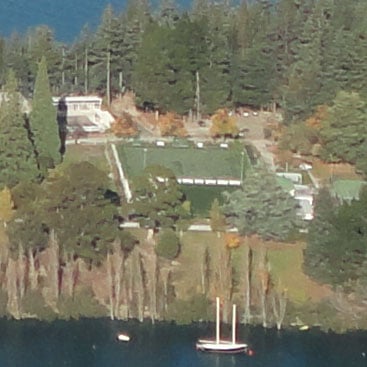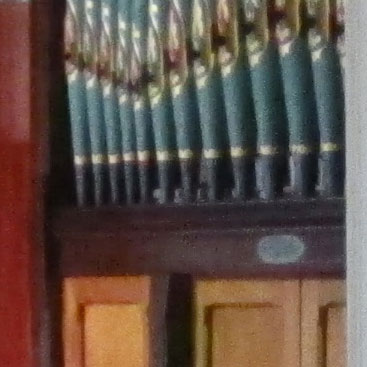Canon IXUS 130 / PowerShot SD1400 IS
-
-
Written by Gordon Laing
Quality
Canon IXUS 130 / SD1400 IS vs Sony Cyber-shot DSC-W350 Real-life resolution (default Program settings)
Canon IXUS 130 / PowerShot SD1400 IS results : Real-life resolution / High ISO Noise
Canon IXUS 130 / PowerShot SD1400 IS results : Real-life resolution / High ISO Noise
|
| To compare real-life performance we shot the same scene with the Canon IXUS 130 / PowerShot SD1400 IS and Sony Cyber-shot DSC-W350 within a few moments of each other using their best quality JPEG settings and lowest sensitivities.The lenses were adjusted to deliver as close a field-of-view as possible; the best match was with the Sony a fraction wider, hence the slighter larger area in its crops. Each camera was set to Program mode without intervention to see how they performed with default settings. |
The image above was taken with the Canon IXUS 130 / PowerShot SD1400 IS at 80 ISO with an exposure of 1/640 and the lens set to 7mm f3.5; the original file measured 3.68MB. As stated above, we allowed each camera to automatically select its own exposure in Program mode, in order to compare how they performed under default settings.
Both cameras have just two aperture settings available at any given focal length, and choose them automatically in all of their shooting modes; there’s no way to override the values chosen. As we’ve seen on many previous tests given this scene, the Canon chose the larger of its two aperture settings (in this case f3.5), while the Sony chose the smaller (in this case f9). Normally the W350’s choice would be cause for concern as smaller apertures on compacts often result in diffraction, but we believe the Sony employs a neutral density filter to simulate a smaller aperture settings. As such we don’t believe the W350’s image is being compromised by its choice of a small aperture value.
The crops below are taken from the areas marked with the red squares and presented here at 100%. In the first row taken from the extreme top left corner, both cameras are suffering from some optical distortion, but the Sony Cyber-shot W350 has it much worse with a quite fuzzy-looking result. To be fair, this clears up quite well as soon as you move away from the extreme corner, and it should also be noted both cameras performed well in their corners when fully zoomed-in and fully zoomed-out. But at this particular focal length, just a couple of notches in from the widest setting, the Sony W350 is visibly softer in the extreme top left corner.
Moving away from the corners for the remaining three rows of crops though, the Sony W350 greatly improves and you can see clear differences in image processing strategies. Using their default settings, the Sony W350 is applying greater sharpening and contrast for a punchier-looking result; this is most likely thanks to its Dynamic Range Optimiser, which is on by default, so applied in this test. Canon also offers a dynamic range booster called i-Contrast, but it’s off by default, so not applied here – you can see an example of it in our main review page.
The end-result with their default settings are quite different on the second row of crops where the Canon looks quite soft and muted in comparison. At first glance the Sony W350 appears preferable, but look really closely and there’s actually roughly the same real-life detail present – it’s just that the Sony has made it more obvious with stronger processing.
Moving onto the third row of crops, the differences become less obvious, with a similar degree of real-life detail. Pixel-peepers may however notice a little more smearing on the Sony sample, especially in foliage areas; it has a water-colour appearance at times with a loss of ultimate detail.
This smearing has also had a minor impact on the large tree in the fourth row of crops, but beyond that, both cameras are recording and delivering essentially the same degree of detail.
If you’re a demanding pixel-peeper, we’d say the Canon IXUS 130 / SD1400 IS enjoys a small edge over the Sony Cyber-shot W350. There’s less smearing of the finest detail and it was better-corrected in the top left corner at the focal length tested here. But the smearing in this sample was pretty minor, and the Sony optics were fine in the corners of other focal lengths tested. So unless you’re a dedicated pixel-peeper who’ll scrutinise their images on-screen at 100%, we’d call it a draw for outdoor shots in decent light.
But what about low-light conditions? Find out how they compare in our High ISO Noise results, or if you’ve seen enough, head straight to our Verdict.
Canon IXUS 130 / PowerShot SD1400 IS | Sony Cyber-shot DSC-W350 | |
 |  | |
f3.5, 80 ISO | f9, 80 ISO | |
 |  | |
f3.5, 80 ISO | f9, 80 ISO | |
 |  | |
f3.5, 80 ISO | f9, 80 ISO | |
 |  | |
f3.5, 80 ISO | f9, 80 ISO |
Canon IXUS 130 / SD1400 IS vs Sony Cyber-shot DSC-W350 High ISO Noise (default Program settings)
Canon IXUS 130 / PowerShot SD1400 IS results : Real-life resolution / High ISO Noise
Canon IXUS 130 / PowerShot SD1400 IS results : Real-life resolution / High ISO Noise
|
 | To compare noise levels under real-life conditions we shot this scene with the Canon IXUS 130 / PowerShot SD1400 IS and Sony Cyber-shot DSC-W350 within a few moments of each other using their best-quality JPEG settings and at each of their ISO settings.The lenses were adjusted to deliver as close a field-of-view as possible; the best match was with the Sony a fraction wider, hence the slighter larger area in its crops. Each camera was set to Program to see how they performed with default settings, although DRO was disabled this time on the Sony as it can introduce noise. |
The image above was taken with the Canon IXUS 130 / PowerShot SD1400 IS in Program mode at 80 ISO with an exposure of 0.5 seconds and the lens set to 7mm f3.5; the original file measured 2.86MB. The crops below are taken from the area marked with the red rectangle and presented here at 100%.
At their lowest sensitivities of 80 ISO, both cameras deliver detailed and fairly clean results. Look closely and pixel-peepers will notice the usual fine textures common across all compacts these days, even at their lowest ISO settings, but most people would be perfectly happy with the results in this first row of crops. As seen on the previous page, the Sony Cyber-shot W350 is applying greater sharpening and contrast, even with the Dynamic Range Optimiser disabled for this low light test. This doesn’t make it better – it’s just a different approach to image processing and the choice between it and the Canon IXUS 130 / SD1400 IS at this point is entirely personal.
At 100 ISO the Canon IXUS 130 / SD1400 IS delivers essentially the same result as it did at 80 ISO. Sure the textures have become fractionally greater, but that’s getting into serious pixel-peeping. In contrast though, the Sony Cyber-shot W350’s image quality has taken quite a hit in the small jump from 80 to 100 ISO. Noise levels have noticeably increased, the image looks softer overall and fine details are already being lost. Again there’s a fair amount of pixel-peeping going on here, and most wouldn’t notice any negative impact on prints, but when examining at 100%, it’s clear the Canon IXUS 130 / SD1400 IS enjoys a visible advantage at 100 ISO.
At 200 ISO there’s a drop in quality on both models, but this time it’s the Canon which suffers from a bigger drop compared to its previous setting – the IXUS 130 / SD1400 IS looks noticeably less crisp than it did at 100 ISO. But the Canon result at 200 ISO remains preferable to that from the Sony which is becoming increasingly plagued by noise and processing artefacts.
With the sensitivity set to 400 ISO, both cameras are becoming steadily fuzzier and losing more subtle details, especially in terms of tone – for example, the markings on the organ pipes are much less defined than at lower sensitivities. We’d still say the Canon enjoys and edge here, but it’s smaller than before with both cameras being quite close in overall quality at this point.
At 800 ISO, the Canon IXUS 130 / SD1400 IS has begun to really suffer with a loss of fine detail and an overall softness to the image. In turn, the Sony W350 has become quite patchy, but while its stronger contrast and sharpness by default makes the artefacts more obvious, we prefer its output at this point to the Canon.
Likewise at 1600 ISO where the Sony W350’s punchier-looking image processing gives it the impression of a superior result. Look closely though and you’ll see both cameras are roughly neck-in-neck on actual detail, but we personally prefer the Sony result. This is personal though and you may prefer the Canon.
The IXUS 130 / SD1400 IS tops-out at 1600 ISO, but offers a Low Light scene preset which significantly drops the resolution in an attempt to reduce visible noise. It works too when viewed at 100%, but of course when printed or viewed the same size, the artefacts on the normal 1600 ISO version will appear smaller and less obvious.
The Sony W350 bravely offers a 3200 ISO option at its full resolution, and while it’s unsurprisingly very noisy at this point, it may be acceptable for emergency situations.
So an interesting result here with no clear winner overall. Both cameras start looking roughly the same at 80 ISO, but the Canon IXUS 130 / SD1400 IS enjoys a noticeable lead at 100 and 200 ISO, and a small edge at 400 ISO. At 800 ISO and above though, the Sony W350 comes back with results we personally preferred to the Canon; this is however a personal preference and you may think the Canon still looks better. If you think you’ll be shooting at 400 ISO or lower, then the Canon IXUS 130 / SD1400 IS will be the preferred choice, but if you regularly shoot in low light at 800 ISO and above, you may prefer the Sony W350.
Check out our Sample Images Gallery for more examples across the Canon’s sensitivity range, or if you’ve already seen enough, head on over to our verdict!
Canon IXUS 130 / PowerShot SD1400 IS | Sony Cyber-shot DSC-W350 | |
 |  | |
80 ISO | 80 ISO | |
 |  | |
100 ISO | 100 ISO | |
 |  | |
200 ISO | 200 ISO | |
 |  | |
400 ISO | 400 ISO | |
 |  | |
800 ISO | 800 ISO | |
 |  | |
1600 ISO | 1600 ISO | |
 |  | |
Low Light preset (here at 1600 ISO) | 3200 ISO |






